So, you want to play historicals do you? Maybe count a few buttons? Feel like doing some research by digging through several layers of dirt? Palaeo Diet: Eat or be Eaten checks that box when you stretch the definition of that, being more of a survival sim than a wargame. The premise is simple: you are a hunter-gatherer in paleolithic times, trying to provide enough food for your tribe, and you are definitely not on the top of the food chain.
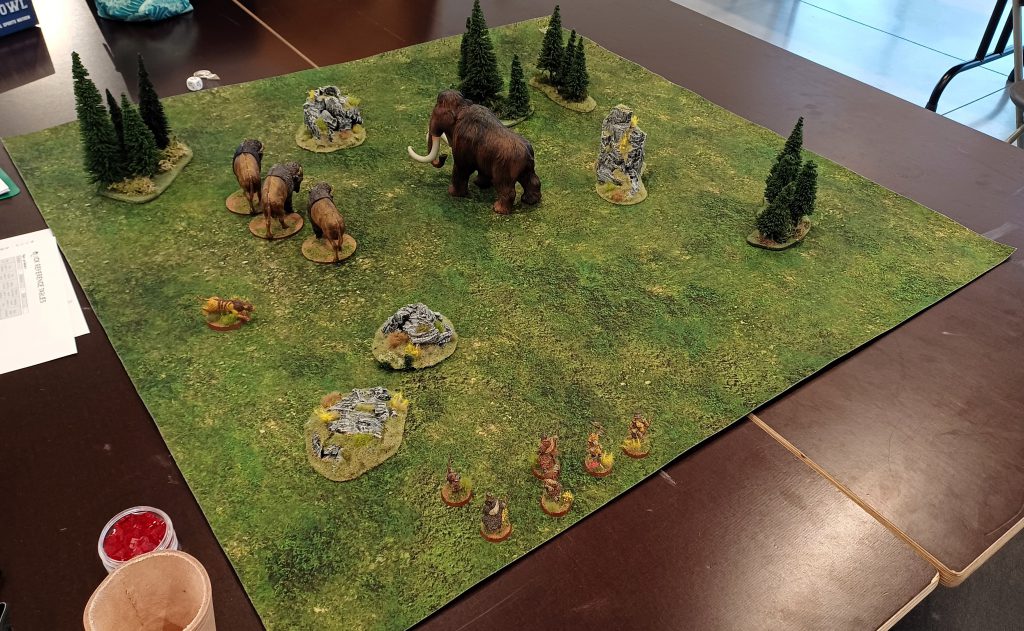
While it is possible to take on rival tribes, the rules have co-op or solo play as a goal. There simply weren’t enough people around to have sweeping battles (looking forward to the comments on this one), and war takes time, energy, and resources, not something readily available at the time. At its core, it has a simple and robust set of mechanics that make for entertaining and short games.
The lay-out and design of the book reflect this philosophy. Clocking in at 53 pages and illustrated with some cute and cartoony images, you won’t get a detailed explanation of what we know of paleolithic times. It’s simply classified as “prehistoric”, and veers more into “caveman with bone in hair” territory. This is not necessarily a bad thing. The game is model and scale agnostic, and there’s a pulp variant where you can hunt dinosaurs, so casual fun is the keyword here.
Lenoon editor note: This was my study period for a long time. For a brief introduction to Britain at least, check out Frances Pryor’s Scenes from Prehistoric Life
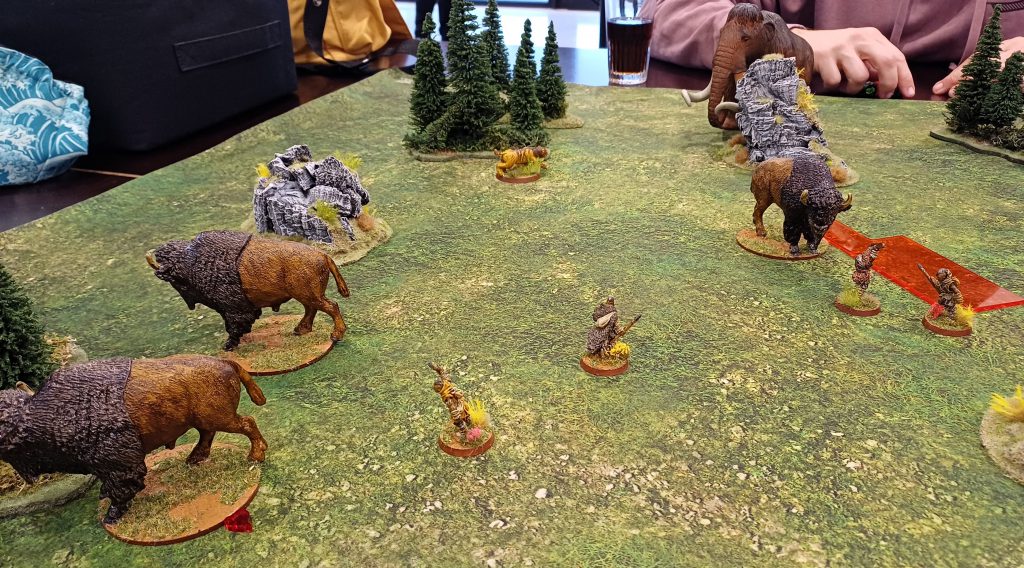
How to hunt in 10,000 BC, or thereabouts
To start your hunt, or at least kit out your hunters, you do not have the luxury of high powered rifles. There is a basic set of tools at your disposal, from a simple club to a bow. Ranges are small, and getting hits in is hard. You can use fire to flush out animals, or drive them to hunters waiting in ambush. And this is where the system excels, and the fun comes in. Your basic hunter or beast only has three stats: Savagery, Resilience, and Bulk. All stats are simple target numbers on a 6-sided die. Savagery is only used when a beast attacks a member of your tribe. Resilience is the to-hit score for your spears and arrows. Bulk is wounds, and the amount of meat you get when killing a beast. The only active participants in your hunt are your own tribe. They can take up to three actions, needing a dice roll to succeed. You start out with two “fresh” dice, needing a 2+ to activate. You get another red or “stressed” die, needing a 4+. What keeps you from using all three actions all the time is that a failed roll will make the beasts on the table react. All wildlife has a reaction table, with different outcomes on what you’re trying to achieve. Venture too close and they might run off. Throw a spear at a wounded animal and it might turn around and try to trample you. Apex predators will kill you if provoked and are attracted to wounded animals and the smell of blood, going from fairly passive to actively stalking, and trying to feed from your kill. A D6 roll on the table will give you an appropriate reaction. For every wound the beast has, add 1 to the reaction, increasing the chance of an enraged attack. There are also different columns for being attacked or having a hunter nearby. Your hunters only have two wounds, so if an annoyed mammoth tramples you, you switch out one of your fresh dice for a stressed one. This will make taking actions significantly harder and risky.
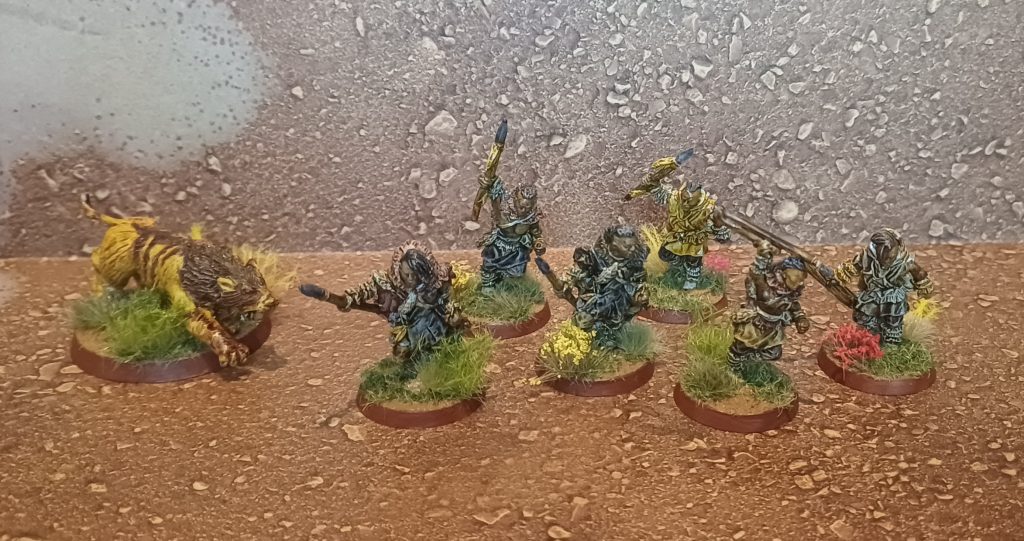
Simply rushing in and trying to move fast will make your hunters go on a jolly little romp around the local scenery. Teamwork is of the essence and a good hunter will know when to sneak and when to run. This friction works great in co-op with multiple players, as people will have to work together to avoid starvation. You can also use doggies if you want! Hounds can assist you and are more or less under control of the player. They are still pretty wild, so on a failed activation roll they won’t necessarily attract attention as a hominid face planting in the brush, but return to their master or go after wounded prey. You can premeasure at all times, and like the stats, you only have three simple range bands to remember: short, medium and long, which roughly translates to 3, 5 and 7 inches at 28mm.
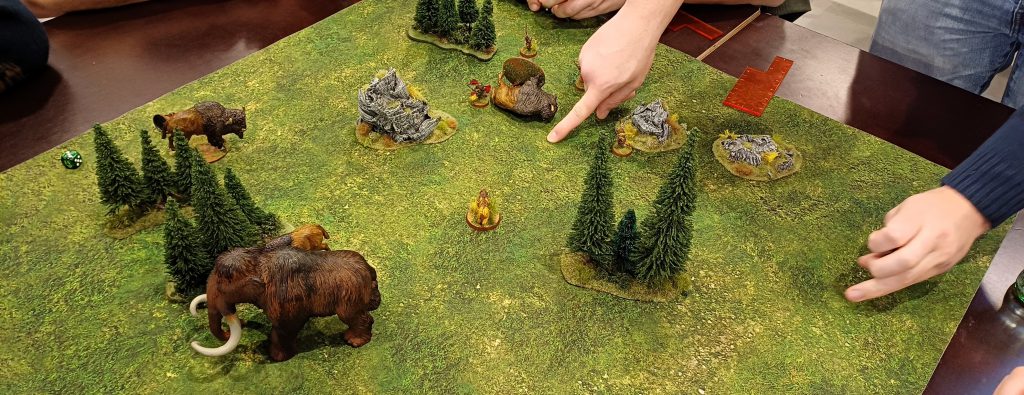
Spring, summer, fall, winter… and spring
There is a rudimentary campaign system which links a couple of scenarios. The “Fireside tales” expansion has a dedicated campaign which takes this a bit further, with added extra beasts! What you get is a whole bunch of different beast profiles from giant grazers like mammoths to angry critters like badgers, combined with some basic scenarios (where hunting or killing isn’t always mandatory). It is a system that actively encourages you to make up your own hunts.
And so we come to the bulk of the review; what do you get out of this? While solo play is definitely an option, it absolutely shines as a co-op game. This is pretty much the historical equivalent of a party game, where you can easily pick up the rules after a round of play, and will need to confer with other players on how to tackle the hunt. The gameplay is tense enough, and the reactions of the beasts are chaotic, and especially when wounded, dangerous. A typical game will run from half an hour to an hour tops, with little downtime, even when you’re playing with 6 people. This makes it ideal to for a small campaign in an evening or afternoon.
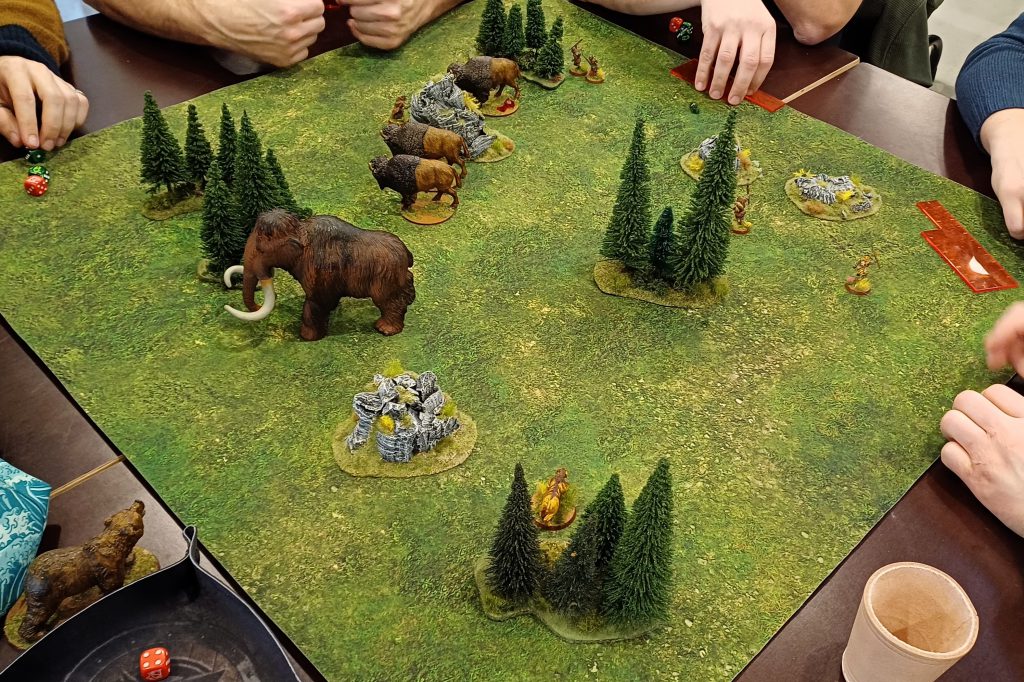
I ran this during a game day at my club, with a simple scenario, some big grazers and a sabertooth tiger. People would be waiting for an opponent or finishing up a larger game and have a quick half an hour go at it. After running 8 of these, reactions were universally positive, and each game felt very different, but always fun. This also seems like something kids might enjoy, and it’s straightforward enough that younger would-be gamers won’t feel overwhelmed.
Much like the game, what you need to play is fairly simple. although you may need to source some appropriate hunters. North Star figures has a nice range from Lucid Eye and their Savage Core range, and Steve Barber Models has some nice beasties as well as a fishing coracle! I haven’t really checked out 3d printing ranges, but I bet there’s some stuff out there. For beasts, I used dollar store bison which looked suitable enough after a quick paint job, and found a toy mammoth online. Since I already had some woodland scenery, the total cost of the project was about £40/$50/€46, rules included. I think that toy mammoth was the most expensive thing. A fun little side project which you can knock out in an afternoon or two. The suggested playing area is 3×3, although a 4×4 might be a bit better for larger scenarios. This is pretty easy to fill up with some woodland scenery, and you don’t need that much, grazers need some space to graze of course.
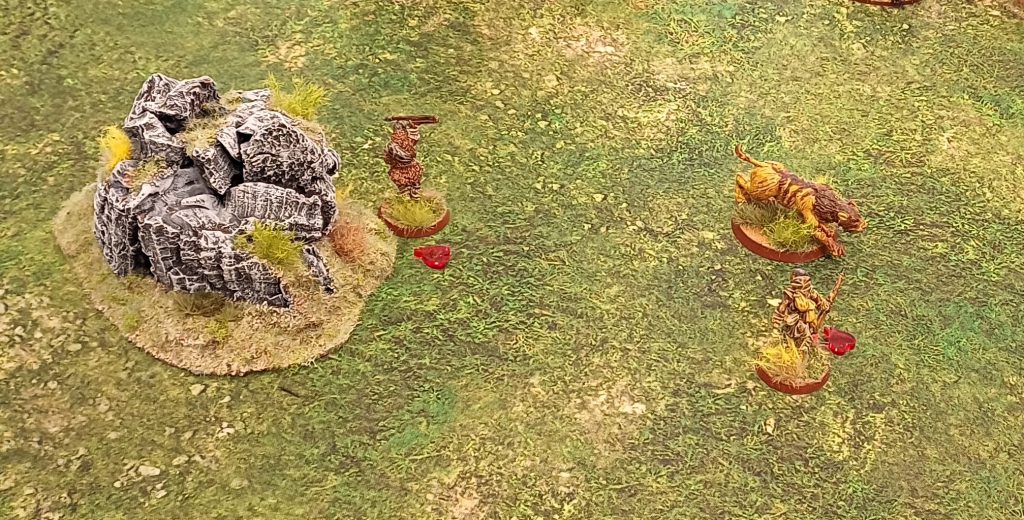
You should buy this now and go hunt mammoths
At the end of the day (and this rather short review), if you’re looking for a light, but very fun co-op game to fill an evening where you really want to fill up on beer and pretzels and have a good time with gaming friends, Palaeo Diet has you covered. It’s low cost and straightforward nature will have you playing in minutes. It handles crowds well, and making up your own scenario is easy enough. For games with more than 4 players I would recommend a GM to roll the reactions of the beasts and steer the game a bit. It’s a crowd pleaser that gets the co-op and multiplayer part right. At a mere £8/$10/€9, I would definitely recommend getting it and having a go, even if it hits the tabletop a couple of times a year or at a club event. You will not regret it!
You can find these rules in pdf-format at the Ganesha Games website or Wargame Vault
Questions, Comments, Suggestions? Contact@goonhammer.com or leave a comment below


